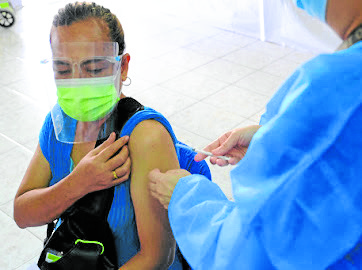
DAVAO CITY INFORMATION OFFICE PHOTO
DAVAO CITY — The Inter-Agency Task Force for the Management of Emerging Infectious Diseases (IATF) has placed Davao City under modified enhanced community quarantine (MECQ), the second most stringent quarantine classification, starting on June 5 to curb the rise of coronavirus disease infections here.
Presidential spokesperson Harry Roque Jr. announced the decision on Friday, just two days after Mayor Sara Duterte made the request to elevate the city’s quarantine level until the end of the month.
Duterte’s request was prompted by the high daily growth of COVID-19 cases in the city, which has so far resulted in the lockdown of five call centers and the City Council building. But instead of imposing MECQ up to the end of the month, the IATF cut it short to June 20.
Alex Roldan, director of the Department of the Interior and Local Government in Davao Region and chair of the regional IATF, said the MECQ status could be extended beyond June 20 if needed.
The city has been under general community quarantine, the second most relaxed classification, since Nov. 20 last year. But cases have been steadily rising since May, with patients overwhelming the Southern Philippines Medical Center, the COVID-19 referral hospital based in the city, getting overwhelmed by the spike of patients seeking treatment.
Losses
Cagayan de Oro City, Northern Mindanao’s capital, is also facing a spike in cases and was placed under MECQ from June 1 to June 15. It is now projected to lose P2 billion to P2.5 billion in economic output due to restrictions under the classification.
National Economic Development Authority Regional Director Mylah Faye Aurora Cariño told reporters on Friday that the estimate was based on the assumption that up to 75 percent of the city’s businesses would cut back on operations.
Cariño said the wholesale and retail trade sector would take the major beating during the MECQ period.
The region has 37,340 total registered businesses as of 2018, of which 9,871 are located in Cagayan de Oro, accounting for 99,875 employees, data from the Philippine Statistics Authority showed.
Bicol, too
In Bicol Region, hospital rooms were also getting full amid a spike in COVID-19 cases in the provinces of Albay, Camarines Sur and Sorsogon.
Dr. Ferchito Avelino, assistant director of the Department of Health in Bicol, said the region’s three government referral hospitals located in the cities of Legazpi in Albay and Naga in Camarines Sur have 957 beds allocated for COVID-19 patients but only 411 or 43 percent are available for occupancy.
More worrisome, he said, was that of the 45 intensive care unit beds allotted to COVID-19 patients in these hospitals, 38 beds or 80 percent were already occupied.
The same situation was happening in Sorsogon where COVID-19 beds at the provincial hospital was 70-percent full, he added.
“Looking at the current condition in all COVID-19 hospitals (in Bicol), the situation is getting quite critical,” he said. —CARMELITO Q. FRANCISCO, FRANCK DICK A. ROSETE AND MAR ARGUELLES